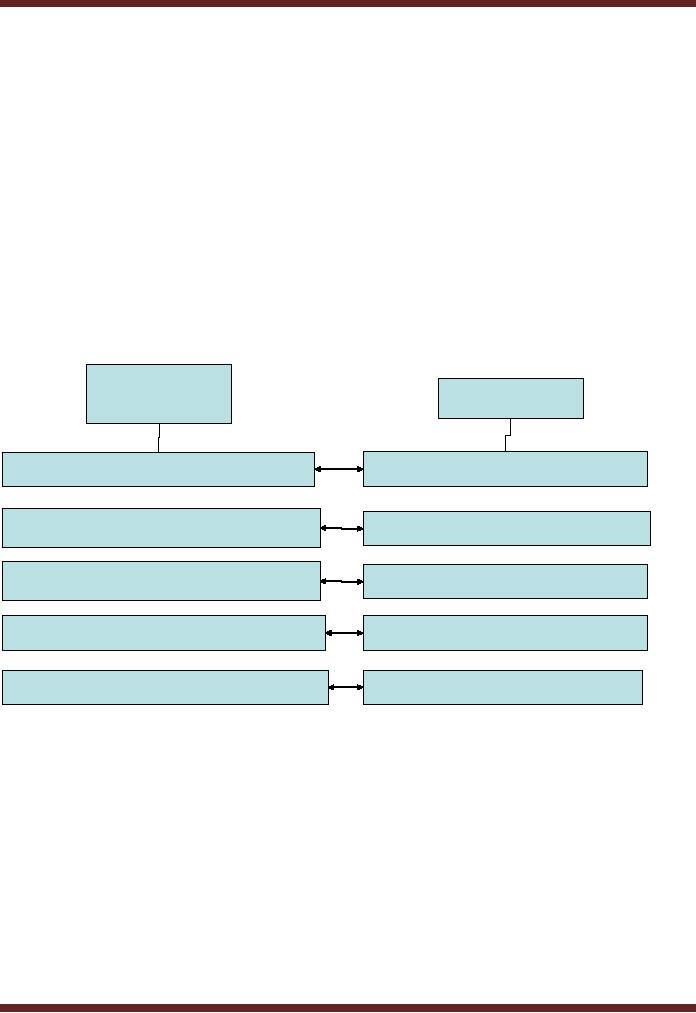 |

VU
Information
System (CS507)
support
system (DSS) typically provides a
spreadsheet style "what if?"
analysis capability, often for
only one
department or
one product at time.
LESSON
12
CBIS
from Functional View
Point
CBIS
can be divided into
subsystems based on how the
users are grouped in the organization.
This
grouping
of users is in terms of related
tasks that are performed.
These conceptual systems are
mirror
images
of physical systems that are
present. These systems are
collectively called Organizational
Information
systems (OIS).
12.1
Organizational Information Systems
(OIS)
The
term OIS views organization as a
combination of process oriented
groups whose information
needs are
related
but independent. All functional
systems should work together for
problem solving since each
system
specialises
in specific domain of information.
Organizational
Information
Organization
Systems
Marketing
Department/Function
Marketing
Information System
Manufacturing
Information System
Manufacturing
Department/Function
Financial
Information System
Finance
Department/Function
Human Resource
Information System
HR
Department/Function
Information
Resource Information System
IR/IT
Department/Function
12.2
Marketing Information Systems
(MKIS)
MKIS
is a type of Information System that
helps the firm to achieve
following objectives:
o Identification
of customers for firm`s products
and services.
o Development
of those products and services to
meet customers' needs
o Promotion
of the products and services,
and
o Provision
of after sale customer
support
Types of
Marketing Information
Every
information system is designed to
capture some sort of
information. Information requirements
need
to be
defined before the systems are
made. While designing marketing
information system, following
types
of
information should be designed.
42

VU
Information
System (CS507)
·
Marketing
Intelligence information flowing
from environment into the
environment
·
Internal
Information gathered within the
firm
·
Marketing
Communication Info flowing from
firm to external environment
An
MKIS help in proper
management and dissemination of
all three kinds of
information.
12.3
Benefits of Marketing IS
MKIS
helps organizations in efficient
channel management. Following
can be identified as some of
the
benefits of
MKIS.
1.
Customer profiles need to be maintained
focusing on their habits and
spending patterns.
MKIS
helps
in maintaining these profiles.
2.
Information on what competitors have been
upto is also a critical marketing
information. This
should
not be taken as espionage on
competitors.
3.
Forecasts of demand is also a critical
part of marketing analysis. MKIS
helps in achieving this as
well.
4.
Field sales can also be
monitored where sales agents
are used to market
products.
5.
Customers can be quickly
updated based on their
information kept in
MKIS.
6.
Dealers involved in sale of
product can also be
monitored to help enhance
revenue.s
12.4
Management Levels in
MKIS
MKIS
should cater for information
requirements at each level, for
instance
Strategic
Level
1.
Formulation of new sales
products, and identifying
new sales
opportunities.
2. Planning
support for new products and
services
3.
Monitoring competitors
Knowledge
Level
1.
Market analysis based on
demographics and customer
behaviour
Management
level
1.
Sales performance analysis is required to
monitor how to enhance sales
and address related
issues.
2.
Sales staff analysis is important to
see how much of the sales
portion has been contributed
by each
of the
employees.
Operational
Level
1.
Taking comments from
customers for measuring
satisfaction is a responsibility of the
managerial
level.
2. Tracking
sales, processing orders and
customer support
12.5
New Dimensions in
MKIS
Through
extensive use of computers in marketing
field, newer concepts are
emerging in marketing field,
which
are revolutionising the way
customers were dealt
with.
o Customer
Relationship management (CRM)
o Sales
Force Automation (SFA)
o Call
Centres
Customer
Relationship Management
43

VU
Information
System (CS507)
·
Businesses
increasingly talk about fostering relationships
with their customers. This
is important
because
some modern businesses have
literally millions of customers.
Hence keeping personal
touch
with
every individual customer is getting
difficult to achieve.
·
Companies
are clearly eager to nurture
relationships with their customers.
Businesses need to
understand
the extent to which consumers want to engage
with their brands. For
some
businesses
there is
· Either
a strong natural need banks
· Or an
emotional attachment Fashion
retailer, car manufacturer
Benefits
of CRM
·
Maintains
and enhances customer
base
·
Encourages
customer loyalty
·
Gaining
more customers'
wallet-share
·
The
more effective a company's customer
retention and defection management
strategy, the
less
they need to plug the gap
with new customers, who
are expensive to recruit.
· CRM
help in establishing communication to
encourage customers to share
information about
their
·
Habits,
·
Tastes
and preferences
·
Interests
in Co's brand extension
initiatives
·
CRM is
a business strategy that
goes beyond increasing transaction
volume.
·
Its
objectives are to increase
profitability, revenue, and
customer satisfaction.
·
To
achieve CRM, a company wide
set of tools, technologies, and
procedures promote the
relationship
with
the customer to increase
sales.
·
Thus,
CRM is primarily a strategic
business and process issue
rather than a technical
issue.
Reasons
for adopting CRM
·
Customers
now prefer to execute
transaction in an electronic environment
through online-trading.
Also
the establishment of customer services
centers has also removed the
inconvenience to access
vendor's
physical locations.
·
Due to
absence of physical contact,
companies are curious to
keep a soft touch in an
efficient manner.
This
requires keeping a customer-wise online
track of past correspondence
and transactions.
·
CRM
reduces cost of sales and
distribution by
·
Targeting
advertising to customers to increase the
probability that an offer is
accepted.
·
Using
web applications to decrease the number of direct
sales people and
distribution
channels
needed
·
Managing
customer relationships rather than manage
products (a change in marketing)
·
CRM
minimize customer support costs
by
·
Making
information available to customer
service representatives so they can
answer any
44

VU
Information
System (CS507)
query
·
Automating
the call centre so that
representatives have direct access to
customer history
and
preferences and therefore can
cross-sell
12.6
Key CRM Tasks
·
Customer
Identification -- Identifying customer
through
·
Marketing
channels,
·
Transactions,
·
Interactions
overtime,
·
Customer
Differentiation Segregating
customers, with respect
to.
·
Their
lifestyles
·
Attitudes
·
Perception about
Co.'s products
·
Customer
Interaction Efforts made to retain
customers for long-term
profitability and relationship.
·
Customization /
Personalization
"Treat
each customer uniquely" is the
motto of the entire CRM process.
Through the personalization
process,
the company can increase
customer loyalty.
12.7
CRM Issues
·
Customer
Privacy
Customer
privacy is an important issue in CRM.
CRM deals with large
amounts of customer
data
through
various touch points and
communication channels. The individual
firm is thus caught in
an
ethical
dilemma collecting as much
information as possible but
still respecting limits for
personal
privacy.
·
Software
issues
There is
little standardized technologies
and protocols for CRM
implementation in the market.
Vendors
publish new versions of CRM
software as frequently as they can
thus adding to client's
expenses.
CRM software requires highly
integrated environment for high
productivity, which is
rarely
available.
Sales
Force Automation
It
automates some of the company's critical
sales and sales force
management functions, for
example,
·
Customer
account management,
·
Forecasting
sales,
·
Sales
administration,
·
Keeping
track of customer
preferences,
·
Sales
staff performance.
SFA
empowers the sales force to close
deals at the customer's office
and to configure marketing
strategies
at
home. SFA is providing tools
for very highly evolved
sales organizations, organizations
that are basically
45

VU
Information
System (CS507)
marketing
machines.
12.8
Call Center
Due to
its direct contact with
customers, call center is widely gaining
popularity. It refers to a
department
within
a company or a third-party organization
that handles telephone sales
and/or service. Call centers
use
automatic
call distributors (ACD's) to
route calls to the appropriate agent. In
addition to a call
centre,
collective
handling of letters, faxes,
and e-mails at one location
is known as a contact centre. As
computers
gain
more and more involvement in
marketing field, presence of a highly
efficient and integrated call
center
has
become inevitable. Call centers should
have direct access to every
customer's track record so as to
help
them
handle queries in an efficient
manner. Modern day call
centers, record the telephonic
conversation
with
the customers, extract a summary of
it, and display it every
time the customer calls so as to
help
attendant review
entire record.
Call
Center-Challenges
Call
centre agents are challenged
daily to navigate disparate, non-integrated
applications as they attempt to
resolve
customer service requests.
The call centre should offer
an integrative solution so that customers
can
be
responded efficiently. Call
canter should help cut long
processing times which add
to customer
frustration
and dissatisfaction with the
company.
Manufacturing
Information Systems
It is an
information system which
deals with the
o Planning,
development and maintenance of production
facilities
o Establishment
of Production goals
o Availability
of production materials
o Scheduling
Management
Levels in Manufacturing Information
System
Strategic
level
1.
Locating new plant which
can save cost
2.
Investment in new manufacturing
technology
Knowledge
Level
1.
Distribute knowledge to drive the
production process
2.
Innovating new forms of manufacturing
processes
Management
level
1.
Monitoring production costs
and resources
Operational
Level
1.
Status of production
tasks
46
Table of Contents:
- Need for information, Sources of Information: Primary, Secondary, Tertiary Sources
- Data vs. Information, Information Quality Checklist
- Size of the Organization and Information Requirements
- Hierarchical organization, Organizational Structure, Culture of the Organization
- Elements of Environment: Legal, Economic, Social, Technological, Corporate social responsibility, Ethics
- Manual Vs Computerised Information Systems, Emerging Digital Firms
- Open-Loop System, Closed Loop System, Open Systems, Closed Systems, Level of Planning
- Components of a system, Types of Systems, Attributes of an IS/CBIS
- Infrastructure: Transaction Processing System, Management Information System
- Support Systems: Office Automation Systems, Decision Support Systems, Types of DSS
- Data Mart: Online Analytical Processing (OLAP), Types of Models Used in DSS
- Organizational Information Systems, Marketing Information Systems, Key CRM Tasks
- Manufacturing Information System, Inventory Sub System, Production Sub System, Quality Sub system
- Accounting & Financial Information Systems, Human Resource Information Systems
- Decision Making: Types of Problems, Type of Decisions
- Phases of decision-making: Intelligence Phase, Design Phase, Choice Phase, Implementation Phase
- Planning for System Development: Models Used for and Types of System Development Life-Cycle
- Project lifecycle vs. SDLC, Costs of Proposed System, Classic lifecycle Model
- Entity Relationship Diagram (ERD), Design of the information flow, data base, User Interface
- Incremental Model: Evaluation, Incremental vs. Iterative
- Spiral Model: Determine Objectives, Alternatives and Constraints, Prototyping
- System Analysis: Systems Analyst, System Design, Designing user interface
- System Analysis & Design Methods, Structured Analysis and Design, Flow Chart
- Symbols used for flow charts: Good Practices, Data Flow Diagram
- Rules for DFD’s: Entity Relationship Diagram
- Symbols: Object-Orientation, Object Oriented Analysis
- Object Oriented Analysis and Design: Object, Classes, Inheritance, Encapsulation, Polymorphism
- Critical Success Factors (CSF): CSF vs. Key Performance Indicator, Centralized vs. Distributed Processing
- Security of Information System: Security Issues, Objective, Scope, Policy, Program
- Threat Identification: Types of Threats, Control Analysis, Impact analysis, Occurrence of threat
- Control Adjustment: cost effective Security, Roles & Responsibility, Report Preparation
- Physical vs. Logical access, Viruses, Sources of Transmissions, Technical controls
- Antivirus software: Scanners, Active monitors, Behavior blockers, Logical intrusion, Best Password practices, Firewall
- Types of Controls: Access Controls, Cryptography, Biometrics
- Audit trails and logs: Audit trails and types of errors, IS audit, Parameters of IS audit
- Risk Management: Phases, focal Point, System Characterization, Vulnerability Assessment
- Control Analysis: Likelihood Determination, Impact Analysis, Risk Determination, Results Documentation
- Risk Management: Business Continuity Planning, Components, Phases of BCP, Business Impact Analysis (BIA)
- Web Security: Passive attacks, Active Attacks, Methods to avoid internet attacks
- Internet Security Controls, Firewall Security SystemsIntrusion Detection Systems, Components of IDS, Digital Certificates
- Commerce vs. E-Business, Business to Consumer (B2C), Electronic Data Interchange (EDI), E-Government
- Supply Chain Management: Integrating systems, Methods, Using SCM Software
- Using ERP Software, Evolution of ERP, Business Objectives and IT
- ERP & E-commerce, ERP & CRM, ERP– Ownership and sponsor ship
- Ethics in IS: Threats to Privacy, Electronic Surveillance, Data Profiling, TRIPS, Workplace Monitoring